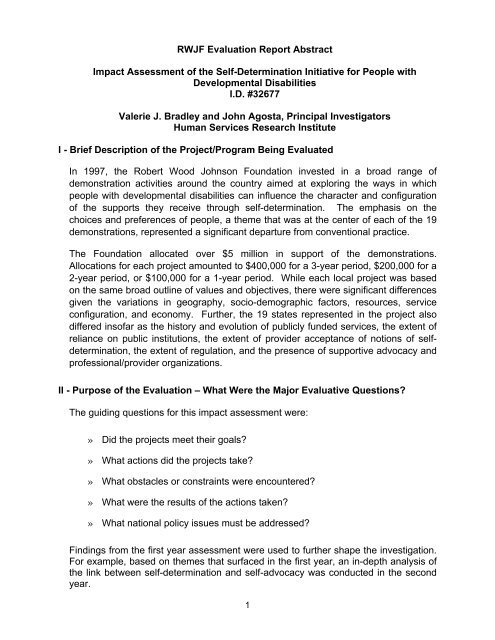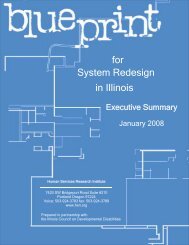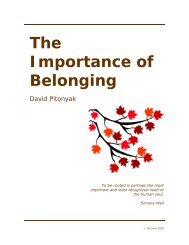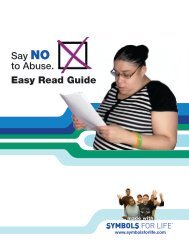RWJF Evaluation Report Abstract Impact Assessment of the Self ...
RWJF Evaluation Report Abstract Impact Assessment of the Self ...
RWJF Evaluation Report Abstract Impact Assessment of the Self ...
Create successful ePaper yourself
Turn your PDF publications into a flip-book with our unique Google optimized e-Paper software.
<strong>RWJF</strong> <strong>Evaluation</strong> <strong>Report</strong> <strong>Abstract</strong><br />
<strong>Impact</strong> <strong>Assessment</strong> <strong>of</strong> <strong>the</strong> <strong>Self</strong>-Determination Initiative for People with<br />
Developmental Disabilities<br />
I.D. #32677<br />
Valerie J. Bradley and John Agosta, Principal Investigators<br />
Human Services Research Institute<br />
I - Brief Description <strong>of</strong> <strong>the</strong> Project/Program Being Evaluated<br />
In 1997, <strong>the</strong> Robert Wood Johnson Foundation invested in a broad range <strong>of</strong><br />
demonstration activities around <strong>the</strong> country aimed at exploring <strong>the</strong> ways in which<br />
people with developmental disabilities can influence <strong>the</strong> character and configuration<br />
<strong>of</strong> <strong>the</strong> supports <strong>the</strong>y receive through self-determination. The emphasis on <strong>the</strong><br />
choices and preferences <strong>of</strong> people, a <strong>the</strong>me that was at <strong>the</strong> center <strong>of</strong> each <strong>of</strong> <strong>the</strong> 19<br />
demonstrations, represented a significant departure from conventional practice.<br />
The Foundation allocated over $5 million in support <strong>of</strong> <strong>the</strong> demonstrations.<br />
Allocations for each project amounted to $400,000 for a 3-year period, $200,000 for a<br />
2-year period, or $100,000 for a 1-year period. While each local project was based<br />
on <strong>the</strong> same broad outline <strong>of</strong> values and objectives, <strong>the</strong>re were significant differences<br />
given <strong>the</strong> variations in geography, socio-demographic factors, resources, service<br />
configuration, and economy. Fur<strong>the</strong>r, <strong>the</strong> 19 states represented in <strong>the</strong> project also<br />
differed ins<strong>of</strong>ar as <strong>the</strong> history and evolution <strong>of</strong> publicly funded services, <strong>the</strong> extent <strong>of</strong><br />
reliance on public institutions, <strong>the</strong> extent <strong>of</strong> provider acceptance <strong>of</strong> notions <strong>of</strong> selfdetermination,<br />
<strong>the</strong> extent <strong>of</strong> regulation, and <strong>the</strong> presence <strong>of</strong> supportive advocacy and<br />
pr<strong>of</strong>essional/provider organizations.<br />
II - Purpose <strong>of</strong> <strong>the</strong> <strong>Evaluation</strong> – What Were <strong>the</strong> Major Evaluative Questions?<br />
The guiding questions for this impact assessment were:<br />
» Did <strong>the</strong> projects meet <strong>the</strong>ir goals?<br />
» What actions did <strong>the</strong> projects take?<br />
» What obstacles or constraints were encountered?<br />
» What were <strong>the</strong> results <strong>of</strong> <strong>the</strong> actions taken?<br />
» What national policy issues must be addressed?<br />
Findings from <strong>the</strong> first year assessment were used to fur<strong>the</strong>r shape <strong>the</strong> investigation.<br />
For example, based on <strong>the</strong>mes that surfaced in <strong>the</strong> first year, an in-depth analysis <strong>of</strong><br />
<strong>the</strong> link between self-determination and self-advocacy was conducted in <strong>the</strong> second<br />
year.<br />
1
III - Summary <strong>of</strong> Methods<br />
Given <strong>the</strong> diversity <strong>of</strong> <strong>the</strong> self determination projects, <strong>the</strong> HSRI evaluation team<br />
initially proposed an evaluation methodology that would document both <strong>the</strong> <strong>the</strong>ory or<br />
model <strong>of</strong> how <strong>the</strong> program is supposed to work, as well as <strong>the</strong> process followed by<br />
<strong>the</strong> demonstration sites and <strong>the</strong> process outputs. The approach proposed for <strong>the</strong><br />
evaluation involved two major components. The first was <strong>the</strong> development <strong>of</strong> a logic<br />
model, and <strong>the</strong> second involved <strong>the</strong> development <strong>of</strong> a “project data base” which<br />
would capture <strong>the</strong> variables associated with each project. Project staff developed a<br />
data collection protocol based on <strong>the</strong>se variables and ga<strong>the</strong>red information from <strong>the</strong><br />
following activities: (1) records and literature review involving analysis <strong>of</strong> secondary<br />
data, (2) telephone interviews, and (3) on-site visits and interviews.<br />
Constraints encountered during <strong>the</strong> first year suggested that a strict quantitative<br />
approach would not be appropriate for <strong>the</strong> final phase <strong>of</strong> <strong>the</strong> evaluation. As a result,<br />
<strong>the</strong> project team made <strong>the</strong> following revisions:<br />
» Selection <strong>of</strong> 10 states on which to concentrate data collection activities. The<br />
10 states included New Hampshire, Massachusetts, Michigan, Vermont, Ohio,<br />
Wisconsin, Kansas, Oregon, Utah and Maryland. The criteria for selection<br />
included <strong>the</strong> momentum for change in those states, <strong>the</strong> length <strong>of</strong> <strong>the</strong><br />
demonstration activity, and geographical distribution.<br />
» Revision <strong>of</strong> <strong>the</strong> interview protocol to reflect an emphasis on implementation<br />
issues and <strong>the</strong> change process ra<strong>the</strong>r than focusing on collection <strong>of</strong><br />
quantitative data.<br />
The impact assessment also included a separate analysis <strong>of</strong> financial management<br />
strategies within <strong>the</strong> demonstration sites. The evaluation <strong>of</strong> selected site consumermanaged/directed<br />
procurement methods was conducted through site visits and<br />
interviews with state and project staff along with <strong>the</strong> review <strong>of</strong> relevant<br />
documentation. Site interviews focused on understanding <strong>the</strong> flow <strong>of</strong> funds and<br />
documenting related procedures for tracking and controlling funds and payments.<br />
IV - Major Findings from <strong>the</strong> <strong>Evaluation</strong><br />
Critical Factors for (or Barriers to) Success…<br />
» Flexibility is key – <strong>the</strong> ability <strong>of</strong> funding systems to accommodate individual<br />
budgets and to expand <strong>the</strong> pool <strong>of</strong> contracted providers. Where systematic<br />
approaches to budget development (e.g., based on costs, and/or individual<br />
characteristics) were already in place (e.g., in Utah and Kansas), <strong>the</strong> task <strong>of</strong><br />
making <strong>the</strong>se individual resource allocations was facilitated.<br />
» The success <strong>of</strong> <strong>the</strong> self-determination initiatives in certain states had to do with<br />
<strong>the</strong> fact that leaders <strong>the</strong>re did not treat self-determination as a “project” but<br />
ra<strong>the</strong>r embedded <strong>the</strong> approach throughout <strong>the</strong> system.<br />
2
» Across <strong>the</strong> country, <strong>the</strong> ability to lead a self-determined life was significantly<br />
influenced by <strong>the</strong> availability <strong>of</strong> direct support pr<strong>of</strong>essionals.<br />
<strong>Self</strong>-determination’s <strong>Impact</strong>…<br />
» The juxtaposition <strong>of</strong> <strong>the</strong> self-determination demonstrations with <strong>the</strong> emerging<br />
aspirations <strong>of</strong> people with developmental disabilities combined to spur <strong>the</strong><br />
growth <strong>of</strong> organized self-advocacy.<br />
» The combination <strong>of</strong> person-centered planning and self-determination has<br />
sharpened <strong>the</strong> practice <strong>of</strong> person-centered planning in many states because it<br />
added person-centered “doing” to person-centered “thinking.”<br />
Future policy considerations…<br />
» Administrative aspects <strong>of</strong> budget and employee management systems can be<br />
extremely complex and may inadvertently give more power to families and<br />
brokers ra<strong>the</strong>r than to individuals. Many states/sites were able to find<br />
workable solutions to <strong>the</strong>se challenges.<br />
» The entailments <strong>of</strong> supporting an individual in a person-centered process is,<br />
according to brokers interviewed, a highly labor intensive process. Given <strong>the</strong><br />
turnover in case managers nationwide, attention must be paid to finding ways<br />
to separate administrative from o<strong>the</strong>r brokerage functions in order to ensure<br />
that adequate attention can be paid to both.<br />
V - Summary <strong>of</strong> Dissemination<br />
The Year One assessment report is currently available on HSRI’s website:<br />
www.hsri.org . The Final <strong>Report</strong> will also be posted on <strong>the</strong> website. Numerous<br />
presentations have been made on <strong>the</strong> findings <strong>of</strong> this study (see list below). Selected<br />
presentations on this topic are also available for viewing or downloading in<br />
Powerpoint format on <strong>the</strong> website.<br />
Publications to date:<br />
Agosta, J., Bradley, V., Taub, S., Melda, K., Taylor, M., Kimmich, M., Semple, A., Kelsch, R. (July<br />
1999). The Robert Wood Johnson Foundation <strong>Self</strong>-Determination Initiative: Year One <strong>Impact</strong><br />
<strong>Assessment</strong> <strong>Report</strong>. Cambridge. Human Services Research Institute.<br />
Bradley, V., Agosta, J., Smith, G., Taub, S., Ashbaugh, J., Silver, J., Heaviland, M. (November<br />
2001). The Robert Wood Johnson Foundation <strong>Self</strong>-Determination Initiative: Final <strong>Impact</strong><br />
<strong>Assessment</strong> <strong>Report</strong>. Cambridge. Human Services Research Institute.<br />
Presentations to date:<br />
Agosta, John (May 1998). Emerging Systems <strong>of</strong> Support for People with Developmental<br />
Disabilities. Everyday Lives Conference. Hershey, PA.<br />
Agosta, J., Moseley, C. & Ward, M. (November 2000). Who is <strong>the</strong> “<strong>Self</strong>” in <strong>Self</strong> Determination.<br />
National Family Support Conference. San Antonio, Texas.<br />
3
Agosta, J. (November 2000). The RWJ <strong>Self</strong> Determination Initiative: Year One <strong>Impact</strong><br />
<strong>Assessment</strong>. Statewide Conference on <strong>Self</strong> Determination. Honolulu, Hawaii.<br />
Agosta, J. (March 2000). The RWJ <strong>Self</strong> Determination Initiative: Year One <strong>Impact</strong> <strong>Assessment</strong>.<br />
CARF National Conference. Tucson, Arizona.<br />
Agosta, J. (February 2001). The RWJ <strong>Self</strong> Determination Initiative: Year One <strong>Impact</strong> <strong>Assessment</strong>.<br />
CARF National Conference. Tucson, Arizona.<br />
Agosta, J. (April 2001). The RWJ <strong>Self</strong> Determination Initiative: Year One <strong>Impact</strong> <strong>Assessment</strong>.<br />
NADDC National Conference. Kansas City, Kansas.<br />
Agosta, J. (July 2001). The RWJ <strong>Self</strong> Determination Initiative: Year One <strong>Impact</strong> <strong>Assessment</strong>.<br />
National Conference on <strong>Self</strong> Determination. Seattle, Washington.<br />
Agosta, J. (February 2002). The RWJ <strong>Self</strong> Determination Initiative: Final <strong>Impact</strong> <strong>Assessment</strong>.<br />
CARF National Conference. Tucson, Arizona. (planned)<br />
Bradley, V. and Taub, S. (May 2001). A Systems-Level Look at <strong>Self</strong>-Determination in Nineteen<br />
States. The American Association on Mental Retardation Annual Meeting. Denver, CO.<br />
Taub, S. (November 2001). Demonstrating <strong>Self</strong>-Determination: An <strong>Evaluation</strong> <strong>of</strong> Policy and<br />
Implementation Issues. Virginia DMHMRSAS <strong>Evaluation</strong> Conference. Richmond, Virginia.<br />
VI - Recommended Next Steps<br />
Prior to <strong>the</strong>se RWJ demonstrations, antecedents to self determination can be found in<br />
innovations explored within family support, supported employment and independent<br />
living systems. One can argue that “self-determination” is less a revolutionary concept<br />
and more an evolutionary step that <strong>the</strong> field was already pushing toward. Based on <strong>the</strong><br />
observations and data collection undertaken by <strong>the</strong> evaluators, it is clear that <strong>the</strong><br />
presence <strong>of</strong> <strong>the</strong>se demonstrations definitely hastened <strong>the</strong> progress toward a more<br />
person-driven system <strong>of</strong> supports – especially in those states/sites where <strong>the</strong>re was<br />
already a glimmer <strong>of</strong> understanding and a hunger to go fur<strong>the</strong>r.<br />
This hastening process has permanently altered <strong>the</strong> developmental disabilities field.<br />
Even as RWJ funding for <strong>the</strong>se demonstrations has ceased, <strong>the</strong> talk nationally about<br />
self-determination continues. Federal policy makers at <strong>the</strong> Centers for Medicare and<br />
Medicaid Services are exploring means for keeping Medicaid regulations from<br />
undermining efforts to adopt self determination practices. <strong>Self</strong> advocates in many<br />
states are focusing <strong>the</strong>ir efforts on teaching o<strong>the</strong>r self advocates about selfdetermination,<br />
and are becoming a greater presence at <strong>the</strong> policy making table.<br />
The RWJ initiative has given great momentum to this cause -- <strong>the</strong> idea has been<br />
plainly set free across <strong>the</strong> country. Now, it is up to self-advocates, family members and<br />
o<strong>the</strong>r self-determination proponents to assure that <strong>the</strong> idea is put to practical<br />
application.<br />
For fur<strong>the</strong>r information, please contact <strong>RWJF</strong> Project Officer<br />
Mary Ann Scheirer, Ph.D. at 609-627-7585 or MScheir@<strong>RWJF</strong>.org<br />
4






